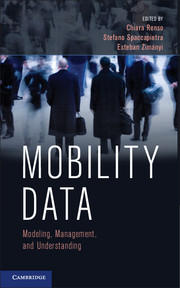Book contents
- Frontmatter
- Contents
- List of Contributors
- Preface
- Acknowledgments
- PART I MOBILITY DATA MODELING AND REPRESENTATION
- PART II MOBILITY DATA UNDERSTANDING
- PART III MOBILITY APPLICATIONS
- 10 Car Traffic Monitoring
- 11 Maritime Monitoring
- 12 Air Traffic Analysis
- 13 Animal Movement
- 14 Person Monitoring with Bluetooth Tracking
- PART IV FUTURE CHALLENGES AND CONCLUSIONS
- Bibliography
- Glossary
- Author Index
- Subject Index
- Plate section
10 - Car Traffic Monitoring
from PART III - MOBILITY APPLICATIONS
Published online by Cambridge University Press: 05 October 2013
- Frontmatter
- Contents
- List of Contributors
- Preface
- Acknowledgments
- PART I MOBILITY DATA MODELING AND REPRESENTATION
- PART II MOBILITY DATA UNDERSTANDING
- PART III MOBILITY APPLICATIONS
- 10 Car Traffic Monitoring
- 11 Maritime Monitoring
- 12 Air Traffic Analysis
- 13 Animal Movement
- 14 Person Monitoring with Bluetooth Tracking
- PART IV FUTURE CHALLENGES AND CONCLUSIONS
- Bibliography
- Glossary
- Author Index
- Subject Index
- Plate section
Summary
Traffic Modeling and Transportation Science
Transportation science, together with its related research fields, is a key discipline of today's society, due to its potential impact on several levels of societal organization and resource usage. In this chapter we will discuss some of the main issues of next generation transportation solutions, and traffic models in particular, and describe case studies where mobility data analysis can help provide some answers.
Relevance of Traffic Modeling
In a research report by the United Nations in 2001, it was postulated that the transport sector accounts for about 25% of the total commercial energy consumed worldwide and that it consumes approximately 50% of the total oil produced. The International Energy Agency (IEA) predicts that the transport sector will overtake industry as the largest energy user by 2020. Unfortunately, that has major negative economic, social, and environmental side effects. At the environmental level, transport has proven to be the source of nitrogen oxides, sulfur oxides, and other volatile organic compounds, all which have negative environmental and health implications. Pollution, environmental degradation, space consumption, and greenhouse gases are receiving increasing attention as the immediately detectable externalities of transport and land-use development patterns. At the economic level, accidents and congestions, traffic gridlocks, stress from pedestrian and vehicular conflict, inefficient public transport, and urban sprawl are all associated with unsustainable transport systems that indirectly represent costs to society.
- Type
- Chapter
- Information
- Mobility DataModeling, Management, and Understanding, pp. 197 - 220Publisher: Cambridge University PressPrint publication year: 2013



